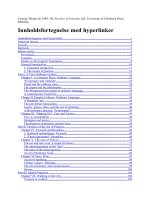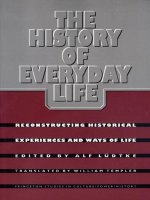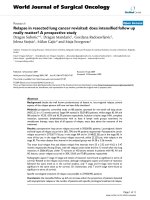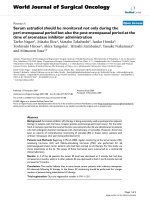At the heart of student migration education, mobility, and the time space production of everyday life
Bạn đang xem bản rút gọn của tài liệu. Xem và tải ngay bản đầy đủ của tài liệu tại đây (132.74 KB, 8 trang )
ACKNOWLEDGEMENTS
The completion of this thesis would not have been possible without the support,
understanding, and guidance from some important people in my graduate life. While I
wonder if all the people I list below would eventually have a chance to read my
words of thanks and gratitude, I think it is important to document
‘acknowledgements’. First, it creates a space in the thesis to speak about all other
forms of efforts and relations otherwise erased from the ‘academic representation’ of
my research. Second, it allows me to reflect on my academic journey and be
reminded that the time has come for this chapter to close (for another to begin). The
two years of graduate study has been made more fruitful by the following people:
I am deeply grateful to my supervisor, Professor Brenda S.A. Yeoh. You have
been a huge inspiration and role model in my academic journey since the
undergraduate days. I truly enjoyed working with and learning from you. I would not
have travelled this far without your constant encouragement, guidance, and flexibility
as an academic advisor, as well as the numerous opportunities given to me – they
have helped tremendously in grooming me into an aspiring scholar. Words cannot
express my heartfelt gratitude!
Special thanks go to A/P Shirlena Huang and A/P Tracey Skelton for your support
and belief in my academic work. Without your time and effort, my route to
postgraduate study would not have been this smooth.
Several colleagues from the department have given encouragement throughout my
stay with Geography – A/P Pow Choon Piew, Dr Harvey Neo, Dr Jamie Gillen, Dr
Elaine Ho, Dr Sin Harng Luh, Dr Karen Lai. Special mention goes to Dr Francis
Collins (University of Auckland) for unreservedly sharing your ideas and opinions.
Graduate peers constitute a crucial part of my life as a graduate student here at
NUS. ‘Old friends’: Jared Wong, Yong Mingli, Tan Qianhui, Erica Yap; ‘old
seniors’: Su Guojie, Vincent Song, Stacy Oon; ‘new friends’: Jason Lin, Heli Ponto.
The graduate room would be a ‘dead space’ if not for your breath of life. To Dr Woon
Chih Yuan, even though you are a colleague, you have been more a ‘peer’ and
‘friend’ – thanks for the drink sessions and I am sure there will be more to come!
I want to thank the members of Social and Cultural Geographies Reading Group at
the Geography department (NUS) for creating a critical and tolerant learning space
for graduate students to voice their thoughts and opinions. I also want to extend my
thanks to members of the Migration Cluster for their support. Graduate life would
never be the same without ‘intellectual circles’ such as these.
I also thank my ‘usual’ clique of secondary school friends and undergraduate
Geography friends – too long a list to be reflected here – for the countless weekends
of laughter and ‘slacking’ together.
Finally, to my family – mother, sister, and brother – thanks for the patience you
have shown towards my ‘relentless pursuit of study’. Without your accommodation
and understanding, I would not have been able to find the space and time to
concentrate on my studies. Another three more years to go, but I will be back!
i
TABLE OF CONTENTS
Acknowledgements
Table of Contents
Summary
List of Tables
List of Figures
List of Plates
Page
i
ii
iv
vi
vii
viii
Chapter One – Introduction
1.1
A Provocation for Research
1.2
Stories of Student Migration from Singapore
1.3
Research Objectives
1.4
Thesis Map
1
2
4
5
Chapter Two -- Theoretical Junctures
2.1
Introduction
2.2
Globalizing Spaces of Education: a Case of Student Migration
2.2.1 From ‘International’ to ‘Transnational' Student Migration
2.2.2 A ‘Student-Centered’ Perspective: Stories through the ‘Body’
2.3
Critical Perspectives on Young People, Education, and Migration
2.3.1 Lifecourse, Mobility, and Migration
2.3.2 ‘Scholarization’ of Young People’s Lives
2.3.3 The Networks, Connections, and Ties that Bind
2.3.4 The Social (Re)production of Everyday Life
2.4
Unfolding Cartographies of Time
2.4.1 Trajectories
2.4.2 Geometries
2.4.3 Textures
2.4.4 Time, Space, and Geographies of Student Migration
2.5
Concluding Comments
7
8
9
12
14
15
18
20
24
25
27
28
29
30
32
Chapter Three -- Singapore’s Higher Education Landscape
3.1
Introduction
3.2
Education for Internationalization and Global Aspirations
3.3
Singapore as Education Hub in (Southeast) Asia
3.4
Conclusion
34
34
37
40
Chapter Four -- Research Methodologies
4.1
Introduction
42
ii
4.2
4.3
4.4
Assembling Research Subjects: Listening to Whose Voices?
Methodological Techniques
4.3.1 Biographical Interviews
4.3.2 Solicited Diaries and Weblogs
4.3.3 Online Chat
Concluding Comments
Chapter Five -- Education Migration: Stories of Youth, Transition,
and Futurity
5.1
Introduction
5.2
‘Going Away’ for Change and Continuity
5.3
Politics of Pace, Speed, and Slowness
5.3.1 Catching Up with the ‘Global’
5.3.2 Slowing Down ‘Local’ Rhythms
5.3.3 Settling In and Disruptions
5.4
Orientations towards Elusive Futures
5.4.1 Going Home, But Not So Soon
5.4.2 3-Year-Bond: A Future Planned?
5.4.3 A Step at a Time
5.5
Concluding Comments
Chapter Six -- Transnational Intimacy: Spatio-Temporal Production of
Proximate and Distant Lives
6.1
Introduction
6.2
The Times and Spaces of Intimacies: the Story/Strategy of Aulia
6.3
Doing Intimacy I: Information and Communication Technologies
6.3.1 “Ya da ya da”: the Banal Politics of Calling Home
6.3.2 Skype: Virtual Co-Presence and the Intimacy of Bodies
6.3.3 Facebook: an Online Transnational Diary
6.4
Doing Intimacy II: The Persistence and Politics of ‘Visiting’
6.4.1 The Reasons, Rhythms, and Work of Visiting Home
6.4.2 The Cultural Politics of Physical Co-Presence
6.5
Concluding Comments
42
48
48
51
54
54
56
57
61
62
66
69
72
73
76
77
79
81
82
86
88
91
97
99
100
104
106
Chapter Seven -- Conclusion: At the Heart of Student Migration
7.1
Telling Student Migrant Stories
109
7.2
Critical Interventions
110
7.3
Education Mobilities, Social Reproduction, and Time-Space
112
Bibliography
116
iii
SUMMARY
In a recent issue from Progress in Human Geography, Holloway et al. (2010)
proposed that engaging with the literature on children, youth and families advances
our understanding of the social and cultural geographies of education. In their paper,
they foreground existing studies that have sought to place the experiences of
students-as-young people at the center of discussion. This research builds on the
argument that there is inadequate attention paid to the diverse socio-spatial relations
and student migrants’ subjectivities, and aims to construct a more grounded,
intimate,
and accountable rendering of the globalizing spaces of education. In
centering students at the heart of the everyday, quotidian, and transnational
geographies of education migration, geographers have expounded on the power
of space and place in producing, differentiating, and maintaining the sociointeractions and relations of these young people on the move. Whether these are
discussed through their class-travelling aspirations, youthful impulses, changing
subject positions and identities, or the connectivities and ties that bind them with
people and places afar, there is a strong underlying concern with how young
students’ everyday lives unfold through the organization of space and place.
Yet, the social (re)production of everyday life is not only contingent on the
changing constellation of ‘space’/’spatiality’, but also ‘time’/’temporality’. Here, I
am interested in reflecting on, and making clear, how ‘time’ (and ‘space’) is also
complicit in the production of student migrants’ intimate lives. Viewed in this
manner, my research takes student migration as an arena for the making,
maintenance, and resistance of the routinizing effects of globalizing education spaces.
First, I examine how everyday temporalities in the lives of young Southeast Asian
migrant students shape the ways they articulate their education migration experiences
iv
and futures in geographically and temporally sensitive ways. Second, I identify the
key transnational practices involved in the production of the complex geographies of
intimacy to show how personal relationships are constantly made and re-made
through changing socio-spatial and temporal demands. Through the analytical
chapters, I show that the motivations, mobilities and experiences of education
migration, and the diverse transnational connectivities that they are refracted through,
are highly differentiated and constantly (re)made through the changing configurations
of time and space. This underlines the complex and contingent processes that are
involved in the production of human subjectivities and relations at the heart of the
student migration phenomenon.
My research is conducted in Singapore with 30 Southeast Asian overseas
students through a variety of methods, including in-depth semi-structured interviews,
diaries/blogs, and informal (online) conversations. This multi-method approach
allowed me to obtain a more multiple reading of student migrants’ practices of
spacing and timing.
Keywords
Student migration, Times-space, Social reproduction, Everyday life, Singapore
v
LIST OF TABLES
Page
4.1
Profile of Respondents
44
4.2
Observations and Reflections from Research Diary, 24 May 2011
50
4.3
Observations and Reflections from Research Diary, 19 July 2011
52
vi
LIST OF FIGURES
Page
3.1
ASEAN Scholarship, Nurturing Young Minds
39
vii
LIST OF PLATES
Page
4.1
Page from a solicited diary with explicit acknowledgement
that the author is both a ‘character’ and solicitor of the diary
53
5.1
Vignette from Vanessa’s journal entry on 27 June 2011
70
6.1
Skype session on 22 May 2011 with elder brother and his daughter
in the Philippines (top left), parents in U.S. (top right), elder sister
in Vietnam (bottom left), Muriel in Singapore (bottom right)
93
6.2
Skype session on 6 March 2011 with mother (left),
elder brother and his daughter (top right), elder sister asking for
a kiss from the niece (bottom right), Muriel (bottom left)
94
viii









